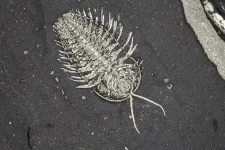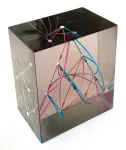(Press-News.org) Access VIDEO, photos and captions here
Climate change and asteroids are linked with animal origin and extinction – and plate tectonics also seems to play a key evolutionary role, ‘groundbreaking’ new fossil research reveals.
The discovery of an exceptionally well preserved ancient primitive Devonian coelacanth fish in remote Western Australia has been linked to a period of heightened tectonic activity, or movement in the Earth’s crust, according to the new study in Nature Communications. (Open access when published)
Led by Flinders University and experts from Canada, Australia and Europe, the new fossil from the Gogo Formation in WA, named Ngamugawi wirngarri, also helps to fill in an important transition period in coelacanth history, between the most primitive forms and other more ‘anatomically-modern’ forms.
“We are thrilled to work with people of the Mimbi community to grace this beautiful new fish with the first name taken from the Gooniyandi language,” says first author Dr Alice Clement, an evolutionary biologist and palaeontologist from Flinders University.
“Our analyses found that tectonic plate activity had a profound influence on rates of coelacanth evolution. Namely that new species of coelacanth were more likely to evolve during periods of heightened tectonic activity as new habitats were divided and created,” she says.
The study confirms the Late Devonian Gogo Formation as one of the richest and best-preserved assemblages of fossil fishes and invertebrates on Earth.
Flinders University Strategic Professor of Palaeontology John Long says the fossil, dating from the Devonian Period (359-419 million years ago), “provides us with some great insight into the early anatomy of this lineage that eventually led to humans”.
“For more than 35 years, we have found several perfectly preserved 3D fish fossils from Gogo sites which have yielded many significant discoveries, including mineralised soft tissues and the origins of complex sexual reproduction in vertebrates,” says Professor Long.
“Our study of this new species led us to analyse the evolutionary history of all known coelacanths.”
Many parts of human anatomy originated in the Early Palaeozoic (540-350 million years ago). This was when jaws, teeth, paired appendages, ossified brain-cases, intromittent genital organs, chambered hearts and paired lungs all appeared in early fishes.
“While now covered in dry rocky outcrops, the Gogo Formation on Gooniyandi Country in the Kimberley region of northern Western Australia was part of an ancient tropical reef teeming with more than 50 species of fish about 380 million years ago.
“We calculated the rates of evolution across their 410 million-year history. This revealed that coelacanth evolution has slowed down drastically since the time of the dinosaurs, but with a few intriguing exceptions.”
Today, the coelacanth is a fascinating deep-sea fish that lives off the coasts of eastern Africa and Indonesia and can reach up to 2m in length. They are "lobe-finned" fish, which means they have robust bones in their fins not too dissimilar to the bones in our own arms, and are thus considered to be more closely related to lungfish and tetrapods (the back-boned animals with arms and legs such as frogs, emus and mice) than most other fishes.
Over the past 410 million years, more than more than 175 species of coelacanths have been discovered across the globe. During the Mesozoic Era, the age of dinosaurs, coelacanths diversified significantly, with some species developing unusual body shapes. However, at the end of the Cretaceous Period, around 66 million years ago, they mysteriously disappeared from the fossil record.
The end Cretaceous extinction, sparked by the impact from a massive asteroid, wiped out approximately 75% of all life on Earth, including all of the non-avian (bird-like) dinosaurs. Thus, it was presumed that the coelacanth fishes had been swept up as a casualty of the same mass extinction event.
But in 1938, people fishing off South Africa pulled up a large mysterious looking fish from the ocean depths, with the ‘lazarus’ fish going on to gain cult status in the world of biological evolution.
Another senior co-author, vertebrate palaeontologist Professor Richard Cloutier, from the University of Quebec in Rimouski (UQAR), says the new Nature Communications study challenges the idea that surviving coelacanths are the oldest ‘living fossils’.
“They first appear in the geological record more than 410 million years ago, with fragmentary fossils known from places like China and Australia. However, most of the early forms remain poorly known, making Ngamugawi wirngarri the best known Devonian coealacanth.
“As we slowly fill in the gaps, we can start to understand how living coelacanth species of Latimeria, which commonly are considered to be ‘living fossils,’ actually are continuing to evolve and might not deserve such an enigmatic title,” says Professor Cloutier, a previous honorary visiting scholar at Flinders University.
The study’s coauthors have affiliations with Mahasarakham University in Thailand, the South Australian Museum, Max Planck Institute for Evolutionary Anthropology in Germany, University of Bristol, Curtin University in Western Australia and the WA Museum.
The article, ‘A Late Devonian coelacanth reconfigures actinistian phylogeny, disparity, and evolutionary dynamics' (2024) by Alice M Clement, Richard Cloutier, Michael SY Lee, Benedict King, Olivia Vanhaesebroucke, Corey JA Bradshaw, Hugo Dutel, Kate Trinajstic and John A Long has been published in Nature Communications. DOI: 10.1038/s41467-024-51238-4.
https://doi.org/10.1038/s41467-024-51238-4
VISUAL CONTENT: go to https://drive.google.com/drive/folders/1-MVOxwOvHoZERYHNT3j7Y29gT6Bz27uq?usp=sharing
VIDEO: Youtube link to come (goes live after embargo lifts).
also Devonian coelacanth, Ngamugawi wirngarri, 3D model of skull from CT data (created by Alice Clement) https://www.youtube.com/watch?v=j-0wLY6Scjc
Acknowledgements: The fieldwork was funded by Australian Research Council DP grants. Prof Cloutier also received funding from the NERC and Natural Sciences and Engineering Research Council of Canada. Thanks to the Gooniyandi people, including Rosemary Nuggett, Elder from the Mimbi Caves Community, and other landholders on which the Gogo fish sites are located.
END
New fossil fish species scales up evidence of Earth’s evolutionary march
Are the world's oldest 'living fossil' coelacanths still evolving?
2024-09-12
ELSE PRESS RELEASES FROM THIS DATE:
Personal carbon footprint of the rich is vastly underestimated by rich and poor alike, study finds
2024-09-12
The personal carbon footprint of the richest people in society is grossly underestimated, both by the rich themselves and by those on middle and lower incomes, no matter which country they come from. At the same time, both the rich and the poor drastically overestimate the carbon footprint of the poorest people.
An international group of researchers, led by the Copenhagen Business School, the University of Basel and the University of Cambridge, surveyed 4,000 people from Denmark, India, Nigeria and the United States about inequality in personal carbon footprints – the total amount of greenhouse gases ...
Tumor-induced B cell changes reveal potential biomarker for treatment response in triple negative breast cancer
2024-09-12
HOUSTON – (Sept. 12, 2024) – Researchers at Baylor College of Medicine and collaborating institutions have discovered new insights into tumor-induced B cell changes in blood and bone marrow of triple negative breast cancer patients. The findings, published in Nature Cell Biology, show two distinct patterns of B cell abnormalities that could serve as blood biomarkers for determining likelihood of response to standard-of-care chemotherapy and immunotherapy.
“Even with significant advances in immunotherapy, ...
Ehrapy: A new open-source tool for analyzing complex health data
2024-09-12
Ehrapy is intended to fill a critical gap in the analysis of health data, says Lukas Heumos, one of the main developers and a scientist at the Institute of Computational Biology at Helmholtz Munich and the Technical University of Munich (TUM): “Until now, there have been no standardized tools for systematically and efficiently analyzing diverse and complex medical data. We’ve changed that with ehrapy.” The team behind ehrapy comes from biomedical research and has extensive experience in analyzing complex scientific datasets. “The healthcare sector faces similar challenges in data analysis as ...
Ozone pollution reduces tropical forest growth
2024-09-12
Ozone gas is reducing the growth of tropical forests – leaving an estimated 290 million tonnes of carbon uncaptured each year, new research shows.
The ozone layer in the stratosphere shields our planet from harmful ultraviolet radiation – and protecting it is one of the major successes of environmental action.
But ozone at ground level – formed by the combination of pollutants from human activities in the presence of sunlight – interferes with plants’ ability to absorb carbon dioxide. Ozone is also harmful to human health.
The new study, published in ...
Study finds doctors and patients interested in environmental impact of health care decisions
2024-09-12
BOSTON – Concerns about the environmental impact of healthcare decisions rarely enter into conversations between patients and physicians. However, evidence from a new study led by researchers at Dana-Farber Cancer Institute, shows there's broad interest in changing that.
In a series of focus groups conducted in different areas of the United States, doctors and patients expressed openness to considering environmental factors when discussing treatment options. The findings, presented in a paper published online today by Nature Climate Change, suggest that educating physicians about the environmental costs of treatment ...
Five key factors predict the response of cancer patients to immunotherapy
2024-09-12
Barcelona, 12 September 2024 – Immunotherapy has transformed cancer treatment in recent years by enabling the immune system to attack tumour cells. However, only 20-40% of patients respond positively to immunotherapy, and these rates vary across different types of cancer. Predicting which patients will respond to immunotherapy and which will not is currently a highly active area of research. Numerous studies conducted so far have focused on the specific characteristics of tumours, their microenvironment, or the patient's immune ...
Trilobite fossils from upstate New York reveal “extra” set of legs
2024-09-12
A new study finds that a trilobite species with exceptionally well-preserved fossils from upstate New York has an additional set of legs underneath its head. The research, led by the American Museum of Natural History and Nanjing University in China, suggests that having a fifth pair of head appendages might be more widespread among trilobites than once thought. Published today in the journal Palaeontology, the study helps researchers better understand how trilobite heads are segmented.
Trilobites are ...
Big algebras: A dictionary of abstract math
2024-09-12
Several fields of mathematics have developed in total isolation, using their own ‘undecipherable’ coded languages. In a new study published in PNAS, Tamás Hausel, professor of mathematics at the Institute of Science and Technology Austria (ISTA), presents “big algebras,” a two-way mathematical ‘dictionary’ between symmetry, algebra, and geometry, that could strengthen the connection between the distant worlds of quantum physics and number theory.
Technical Toolkit: Symmetry and commutativity, from esthetics to functionality
Symmetry is not just a question of esthetics and equilibrium, but also a highly recurrent feature throughout the domains ...
BMI’s relation to cancer therapy mortality risks not so straightforward
2024-09-12
While being overweight increases the risk of developing lifestyle-related diseases, there is a phenomenon known as the obesity paradox where a decreased risk of death has been seen during cancer therapy. However, that paradox might not be the trend for all cancer therapies, an Osaka Metropolitan University team reports in JAMA Network Open, a publication of the American Medical Association.
Led by graduate student Mr. Yasutaka Ihara and Professor Ayumi Shintani of the Graduate School of Medicine’s Department of Medical Statistics, ...
Kids in families with too much screen time struggle with language skills
2024-09-12
Screens have become ubiquitous in our daily lives — which means they’ve also become part of children’s lives too. So what effect does this have on children’s developing brains, especially critical language skills? To understand this, scientists in Estonia surveyed the parents of more than 400 children about their screen use, their children’s screen use, and their children’s language skills. They found that parents who use screens a lot also have children who use screens a lot, and that children’s higher screen time is associated with poorer language skills.
“Our ...
LAST 30 PRESS RELEASES:
Injectable breast ‘implant’ offers alternative to traditional surgeries
Neuroscientists devise formulas to measure multilingualism
New prostate cancer trial seeks to reduce toxicity without sacrificing efficacy
Geometry shapes life
A CRISPR screen reveals many previously unrecognized genes required for brain development and a new neurodevelopmental disorder
Hot flush treatment has anti-breast cancer activity, study finds
Securing AI systems against growing cybersecurity threats
Longest observation of an active solar region
Why nail-biting, procrastination and other self-sabotaging behaviors are rooted in survival instincts
Regional variations in mechanical properties of porcine leptomeninges
Artificial empathy in therapy and healthcare: advancements in interpersonal interaction technologies
Why some brains switch gears more efficiently than others
UVA’s Jundong Li wins ICDM’S 2025 Tao Li Award for data mining, machine learning
UVA’s low-power, high-performance computer power player Mircea Stan earns National Academy of Inventors fellowship
Not playing by the rules: USU researcher explores filamentous algae dynamics in rivers
Do our body clocks influence our risk of dementia?
Anthropologists offer new evidence of bipedalism in long-debated fossil discovery
Safer receipt paper from wood
Dosage-sensitive genes suggest no whole-genome duplications in ancestral angiosperm
First ancient human herpesvirus genomes document their deep history with humans
Why Some Bacteria Survive Antibiotics and How to Stop Them - New study reveals that bacteria can survive antibiotic treatment through two fundamentally different “shutdown modes”
UCLA study links scar healing to dangerous placenta condition
CHANGE-seq-BE finds off-target changes in the genome from base editors
The Journal of Nuclear Medicine Ahead-of-Print Tip Sheet: January 2, 2026
Delayed or absent first dose of measles, mumps, and rubella vaccination
Trends in US preterm birth rates by household income and race and ethnicity
Study identifies potential biomarker linked to progression and brain inflammation in multiple sclerosis
Many mothers in Norway do not show up for postnatal check-ups
Researchers want to find out why quick clay is so unstable
Superradiant spins show teamwork at the quantum scale
[Press-News.org] New fossil fish species scales up evidence of Earth’s evolutionary marchAre the world's oldest 'living fossil' coelacanths still evolving?





